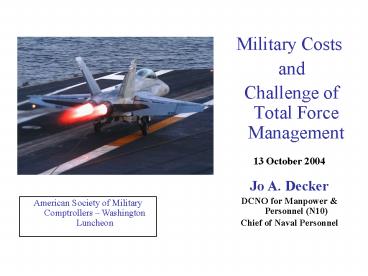Military Costs - PowerPoint PPT Presentation
Title:
Military Costs
Description:
Title: October 04 Luncheon Presentation by Jo Decker Author: william.orton Last modified by: Ernesto.Andrada Created Date: 6/16/2004 6:04:32 PM Document presentation ... – PowerPoint PPT presentation
Number of Views:44
Avg rating:3.0/5.0
Title: Military Costs
1
- Military Costs
- and
- Challenge of Total Force Management
- 13 October 2004
- Jo A. Decker
- DCNO for Manpower Personnel (N10)
- Chief of Naval Personnel
American Society of Military Comptrollers
Washington Luncheon
2
Agenda
- Rising Military Personnel Costs
- Historical Perspective Trends
- Total Force Management
- Human Capital Strategy
- Synchronization Challenge
- MPN POM/Budget
- Resourcing Process Deficiencies
- Way Ahead
3
Historical Perspective
- Before FY01
- Deployments were well defined 6 months every 18
months - Sea/Shore tours were 4 years at sea/ 3 years at
shore - Enlisted ranks were flat at Top 6 of 69
- Retention was low and attrition high
- Since FY01 - USS Cole incident, 9/11 attack,
Afghan War, Operation Iraqi Freedom - Deployments as long as 10 months. Under Fleet
Response Plan (FRP), deployments will vary in the
future. - Sea/Shore tours are being lengthen 5 years at
sea/ 2 years at shore for junior enlisted - The need to increase retention and lower
attrition, increased the need to increase Top 6,
targeted pay raises, incentive pays
4
Military Manpower Requirements Decreasing
Glide Slope 370K Active
members in PRESBUD 04
Glide Slope 357K Active
members in PRESBUD 05
Current Glide Slope 348K
Active members
Navy Active End Strength Profile
Reduction targeted against Overhead and Shore
Installations
5
Average Costs Increasing . . .
TY
AVF Marketplace Fact of Life per capita Costs
Increasing
Officer
Enlisted
6
Result . . . MILPERS share of Navy TOA largely
unchanged
Navy TOA
MPN of Navy TOA
The Opportunity Cost . . . Navy Unable to
invest in Recapitalization Requirements
7
Navy Manpower DeterminationApproximately 830,000
Salaries
180,000 Contractors
48,000 Individuals Account (6) (Students,
transients)
190,000 Civilian
214,000 Battle Forces (26) (Manpower Documents)
85,900 Reserve
568,000 Shore (68) (198,000 Military 190,000
Civilian 180,000 Contractor)
373,800 Active
- Focusing Military on War Fighting
- Concentrating on Shore Support Infrastructure
- Sea Enterprise Efficiencies, Strategic Sourcing
8
Total ForcePast Future
Navy Post-Cold War Drawdown
39.9 Decrease (- 531K)
Contractor
32.5 Decrease (- 87K)
DoN Civilian
39.5 Decrease (- 127K)
Active and Reserve Military
42.8 Decrease (- 317K)
9
Strategic Vision
- Total Force Human Capital Strategy will deliver
the right number of Navy team members. - Active duty uniformed strength represents just
one component of the larger Navy human capital
resource universe. - The Navy will leverage the human capital assets
embedded in our active military, reservists,
civilians, and contractors. - Must be accomplished in a fiscally responsible
manner and within a Total Force context.
10
Our Human Capital Strategy
- Moving toward a Sea-Centric, Forward-Deployed
Force - Recruiting and Retention at All-Time Highs
- Quality of Life and Service Critical
- Revolution in Training for Highly Tuned Skill
Sets - Significant cost-savings are in handmore to come
- Tools and processes for success
- Free up military manpower
- Sea Warrior Initiative
- The Right Sailor with the Right Skills at the
Right Time for the Right Job - Putting the Sailor First in the way we design,
engineer, and operate our ships and aircraft
Re-shaping the ForceReducing CostsWinning the
Battle for People
11
Synchronization Challenge
- Policy changes are not instantaneous time is
required to properly reduce strength and
synchronize targeted billets to targeted Strength
- Funding cannot be removed until Work is
eliminated, Strength reduced - Personnel reductions must be managed by community
and Claimants - Bottom Line Billet reductions must be
synchronized with executable Strength and Funding
profiles to achieve savings
12
MPN Challenge
- Current Business Processes are not Precise
- Programming
- Military manpower priced based upon averages of
averages - Limited data to support decision making
- Budgeting
- MPN budget built on 12 to 24 month old data
- Current methodology presumes Behavior and
External Factors remain the same from year to
year. - Execution
- Each year on average requires significant
reprogramming
Todays legacy systems and methods are based on
processes that have existed for 30 years
13
MPN Challenge
- Transformation critical to
- Capture and use updated Fleet requirements as the
basis for future Strength and Budget projections - Shift to more accurate HR and Pay data sources
- Obtain more granular data with increased detail
- Provide visibility into programming budgeting
assumptions
14
Way Ahead
The Future
Step 1
Step 2
Step 3
- Phased approach - manageable
- Embraces FMMP/BMMP
- Joint
- Pilot enables choices/options
- Builds functionality for the Future
Replace Manpower Programming Budget Process
- FMMP Focus
- Shift to accurate data sources
- Granular data for decision making
FY 2004 CFO Compliant Execution Reports
Replace DFAS Legacy Pay and Reporting
- Forward Looking Focus
- Use Navy NSIPS as source data for pilot to test
evaluate new financial accounting functionality - Build-Test COTS Financial Reporting System CFO
Compliant, Automated Data Entry
- Enterprise Data Warehouse
- Live Personnel Data
- DFAS detailed pay reports
15
Additional Back-ups
16
Sea Warrior Key Manpower Enabler
The best Sailor to the key assignment at the
right time































